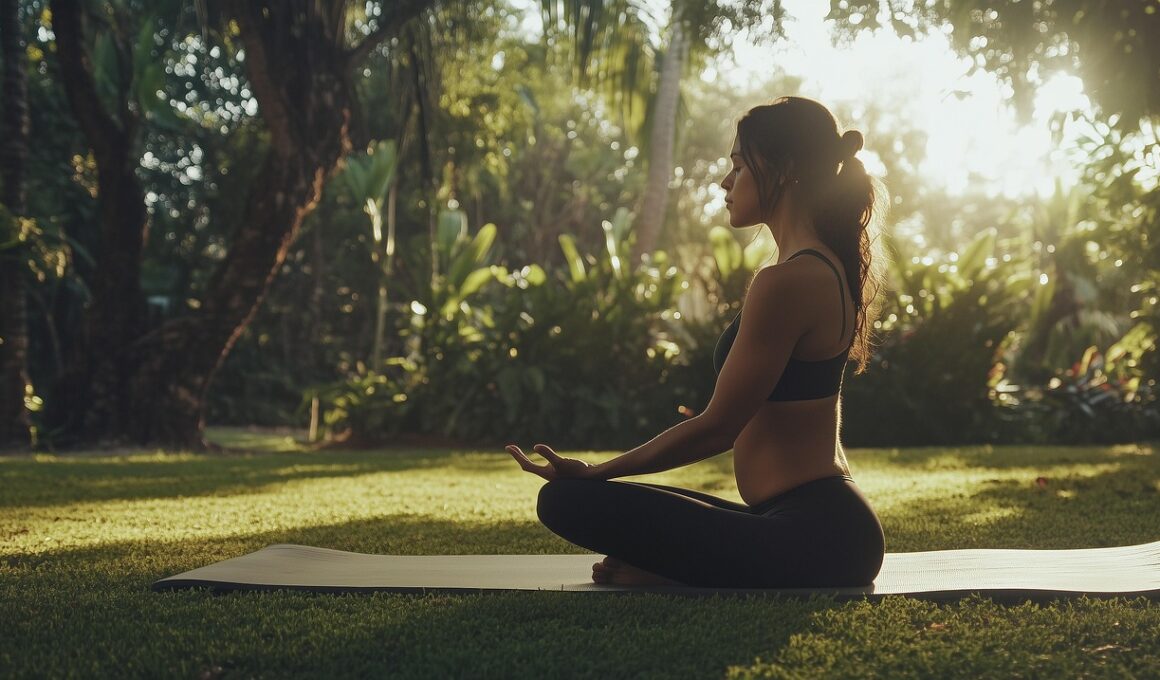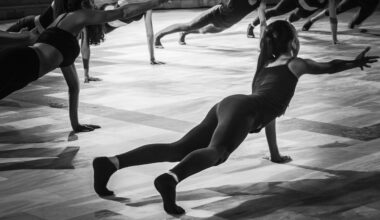The Importance of Breathing Techniques in Group Stretch and Flexibility Classes
Group fitness classes have gained immense popularity over the past few years, particularly those focusing on stretch and flexibility. These classes offer participants a unique opportunity to enhance their physical well-being while fostering a sense of community. The integration of breathing techniques plays a pivotal role in maximizing the benefits of these sessions. When individuals focus on their breath, they create a deeper mind-body connection, allowing them to achieve improved flexibility and relaxation during stretches. Additionally, proper breathing can help alleviate tension and facilitate the release of tight muscles. Understanding how to pair breath with movement is essential for anyone participating in these classes. Instructors often guide participants through various breathing exercises designed to promote awareness of their respiratory patterns. This mindful approach encourages participants to become more attuned to their bodies. Ultimately, effective breathing techniques can lead to enhanced performance and greater overall enjoyment in group stretch and flexibility classes, making these classes both beneficial and enjoyable experiences for all involved. Incorporating these practices can significantly enhance the class atmosphere and contribute to individual progress.
One of the fundamental aspects of incorporating breathing techniques into group fitness is the cultivation of mindfulness. Mindfulness refers to the state of being present and fully engaged in the moment, which is crucial when participating in stretching exercises. By focusing on their breath, participants can cultivate a greater sense of awareness about how their bodies are feeling during the session. This awareness helps in identifying areas of tightness or discomfort, guiding them to adjust their stretching techniques accordingly. Mindful breathing also serves to enhance relaxation, allowing individuals to detach from stressors in daily life and immerse themselves in the present experience. As a result, they are more likely to yield greater benefits from their stretching practice. Instructors can design specific breathing patterns to coordinate with movements, enhancing the overall flow of the exercises. Breathing in sync with the stretches promotes deeper engagement and helps participants achieve their maximum range of motion. The deeper the breath, the more oxygen is delivered to the muscles, ultimately supporting the body’s healing and restorative processes during classes.
The Role of Diaphragmatic Breathing
Another essential breathing technique beneficial in stretch and flexibility classes is diaphragmatic breathing. This technique involves utilizing the diaphragm, a dome-shaped muscle that plays a significant role in respiration, to ensure deeper breaths. By focusing on diaphragmatic breathing, participants activate their core muscles and promote stability throughout their exercises. This stability not only supports their stretching routines but also fosters better posture and alignment. During group sessions, instructors often prompt participants to inhale deeply, allowing the air to fill the abdomen rather than just the chest. This method leads to improved oxygen circulation and can significantly enhance endurance during classes. Participants can experience a greater sense of ease and comfort while holding stretches, which may previously have challenged their limits. Moreover, appropriate breathing techniques help to reduce feelings of anxiety or tension that can accumulate during workouts. As individuals learn how to breathe efficiently, they are empowered to push their boundaries and deepen their stretches safely. Consequently, the experience in group fitness classes becomes enriching, allowing participants to advance their skills over time.
Coordinating breath with movement enhances the overall effectiveness of stretching exercises. As participants synchronize their breath with their actions, they create a rhythmic pattern that facilitates relaxation and ease of movement. This coordinated approach allows individuals to gain deeper insights into their bodies, which can reveal limitations and areas in need of improvement. Instructors play a crucial role in assisting participants as they discover this coordination; they offer guidance on when to inhale and exhale during stretches. Emphasizing breath timing ensures that movements are fluid, moving away from stiffness or resistance. When participants create this harmony between breath and movement, they often experience an increased range of motion, allowing the body to relax more deeply into each stretch. Additionally, this connection reduces the risk of injuries, as movement becomes more intentional and aware. The benefits of breathing techniques extend beyond physical flexibility, as improved focus and concentration during each session promotes mental clarity. As participants develop a consistent practice of coordinating breath with movement, they are likely to embrace a lifelong habit that will enhance their overall fitness journeys.
Facilitating Mind-Body Connection
The mind-body connection refers to the intricate relationship between physical and mental aspects of well-being. Breathing techniques in group stretch and flexibility classes serve to deepen this connection, allowing participants to engage meaningfully with their practice. As they focus on their breaths, individuals develop an increased awareness of their bodies and how they respond to various movements. This awareness fosters a sense of empowerment, as participants learn to listen to their bodies’ signals while stretching. For some, this could mean recognizing when to push further, while for others, it is about respecting boundaries. Instructors often encourage participants to let go of judgment and embrace their unique journey. Such an open environment promotes collaboration and support among class members. With a stronger mind-body connection, participants are likely to feel greater satisfaction with their progress. This holistic understanding of stretch and flexibility is invaluable, as it encourages individuals to adopt a long-term approach to their fitness. Ultimately, leading with breathing techniques serves to create a nurturing space where everyone can thrive and enhance their individual capabilities.
Enhancing group dynamics is another critical aspect positively influenced by incorporating breathing techniques in stretch and flexibility classes. When participants focus on their breath together, they experience a heightened sense of unity within the group. This collective focus fosters an environment of encouragement and motivation, where individuals inspire one another to push their limits. Instructors often highlight the importance of group energy and support, reminding everyone that they share a common goal: improved flexibility and personal growth. Participants may note that the atmosphere feels more connected when everyone breathes in sync, allowing for a stronger sense of community. Additionally, breathing exercises can be incorporated into warm-up or cool-down routines, creating a structured flow that benefits everyone. This structure promotes a cohesive experience, ensuring participants can learn from one another while progressing collectively. The development of relationships within fitness classes enriches the practice, as trust and camaraderie form among members. As individuals support each other throughout their journeys, they become more motivated to attend classes consistently and reach their desired goals. These classes thus foster bonds that can last beyond the fitness studio.
Conclusion
In conclusion, breathing techniques play an essential role in maximizing the benefits of group stretch and flexibility classes. They serve to enhance mindfulness, coordination, and connection among participants, ultimately encouraging personal growth and progress. As individuals learn to integrate proper breathing with their movements, they may unlock a deeper understanding of their bodies, leading to improved flexibility and well-being. Instructors are vital in guiding participants through breathing exercises, offering them the necessary support to develop their skills. By cultivating a cohesive atmosphere within group settings, members are encouraged to connect with one another in meaningful ways. This unity fosters motivation and commitment, allowing individuals to grow and succeed together as a community. Moreover, the holistic approach to fitness adopted in these classes promotes not just physical well-being but emotional wellness as well. As more people delve into the world of group stretch and flexibility classes, they can discover an empowering environment that inspires long-lasting habits. Enhancing connections with one’s body, mind, and other participants leads to transformative experiences, which are essential for anyone embarking on their journey towards health.


